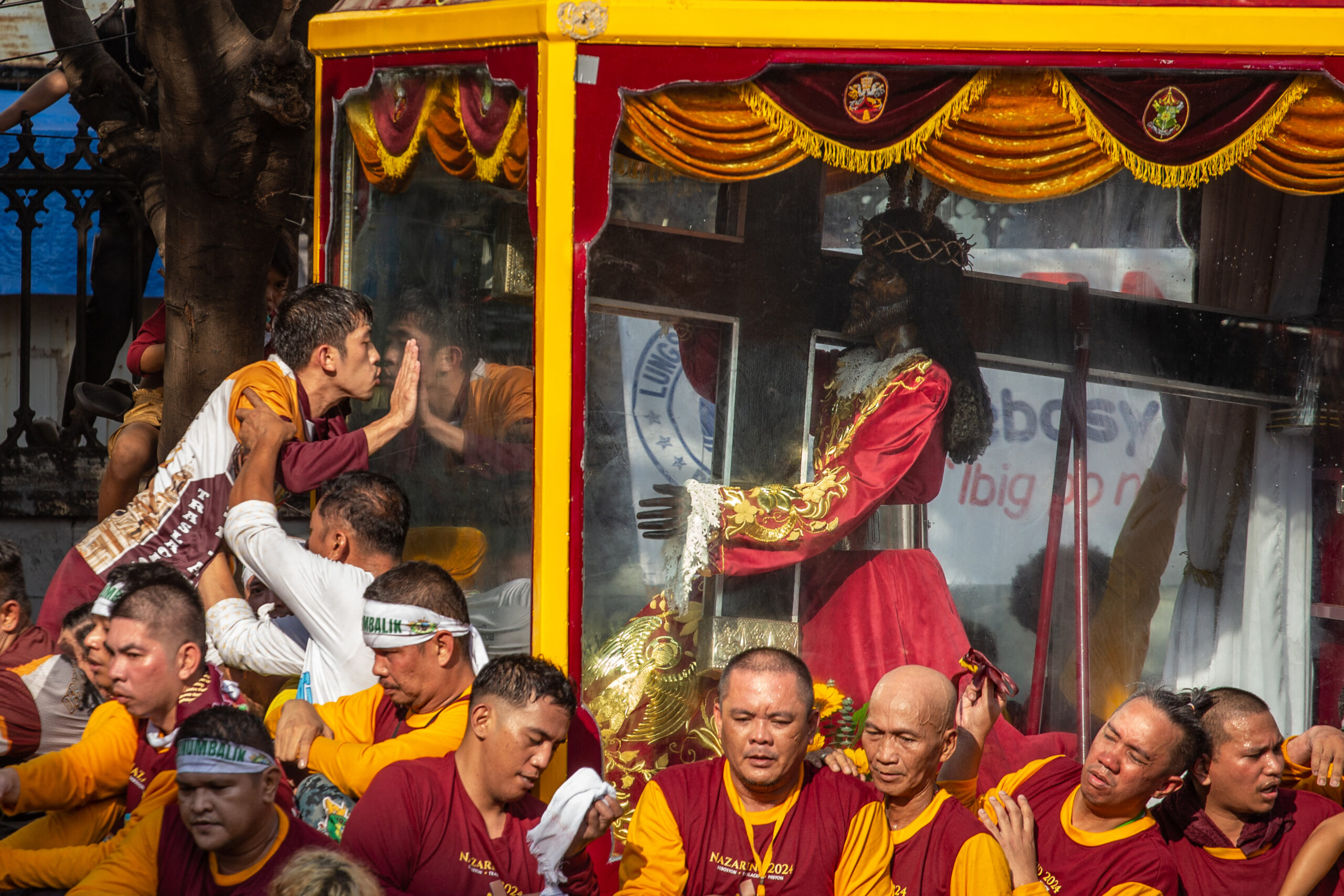EXPLAINER: Why is the annual Nazareno celebration called a feast?

A Catholic devotee kisses the glass cover of the Black Nazarene during the annual religious procession in Manila on January 9, 2024. Hundreds of thousands of Catholic faithful swarmed a historic statue of Jesus Christ as it was pulled through the streets of the Philippine capital on January 9, in one of the world’s biggest displays of religious devotion. —File photo by Earvin Perias | Agence France-Presse
MANILA, Philippines — Millions of devotees from across the country travel to Manila on January 9 of each year to mark the arrival of the image of Nuestro Padre Señor Jesus de Nazareno or Jesus the Black Nazarene from its original home in Luneta to Quiapo in Manila.
The icon, a dark-colored image of Christ bent under the weight of a heavy cross, was made by an unknown Mexican sculptor and was brought to the Church of San Juan Bautista in Bagumbayan, now part of Luneta, by Augustinian Recollect priests on May 31, 1606.
Two years later, in 1608, the image was transferred to San Nicolas de Tolentino’s church in Intramuros. Finally, on January 9, 1787, it was transported to Quiapo Church, which is also known as St. John the Baptist Church.
READ: True Black Nazarene devotees show Christ-like love, says priest
What makes it a “feast”?
Fr. Douglas Badong, parochial vicar of Quiapo Church, explained that the annual religious event is considered a feast due to the nature of the traditions, rituals, and activities linked to the celebration.
“It becomes a fiesta because of the way it is being celebrated, like a usual feast. The celebration is grand; we are celebrating the arrival of the Black Nazarene image here in Quiapo,” Badong said in Filipino in an interview with INQUIRER.net.
“That is the proper term used for the celebration. Because if we will just say ‘Nazareno,’ it feels like something is lacking. What will happen? A celebration. In what way will it be celebrated? Through a feast. That’s why it is called the Feast of the Black Nazarene,” he added.
READ: All quiet in Quiapo again as Black Nazarene feast goes online
Based on the definition provided by Merriam Webster, the word “fiesta” (“pista” or “piyesta” in Tagalog) specifically means “a saint’s day celebrated in Spain, Latin America, and the Philippines with processions and dances.”
When talking about grand traditions and rituals, the most famous practice and the highlight of the Feast of the Black Nazarene is the “Traslacion” or the annual grand procession of the image, which is believed to be miraculous.
The procession attracts millions of devotees who walk barefoot ahead of and behind the life-size image of Jesus Christ carrying the cross. Devotees jostle with each other for the chance to touch the image which is carried by a sea of devotees onboard the “andas” or carriage.
Another part of the celebration is the “pahalik” which is a ritual done by devotees where they kiss the Black Nazarene’s image. People also try to touch or wipe their handkerchiefs on the image.
The difference between the feast on January 9 and June 24
The Feast of the Black Nazarene is often confused with another feast celebrated every June 24 in Quiapo, Manila. The parochial vicar clarified that the latter is a separate or distinctively different event from the January 9 celebration.
“June 24 is the Feast of Saint John the Baptist because Quiapo Church is also called Saint John the Baptist Parish. So, even before the Black Nazarene image was transferred in Quiapo Church, it is already Saint John the Baptist Parish. It is the feast for the saint,” Badong said.
“It’s as if Saint John the Baptist prepared the town for the arrival of Christ [Black Nazarene]. We assign a different date to celebrate Saint John the Baptist, and of course, we celebrate Christ on a different day,” he added.